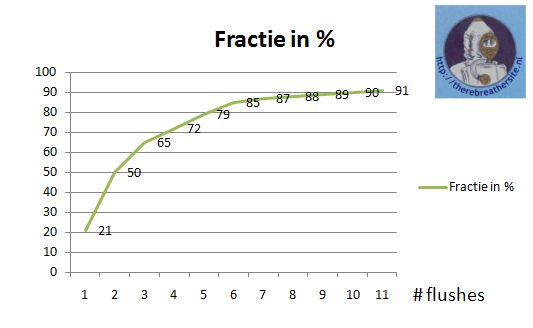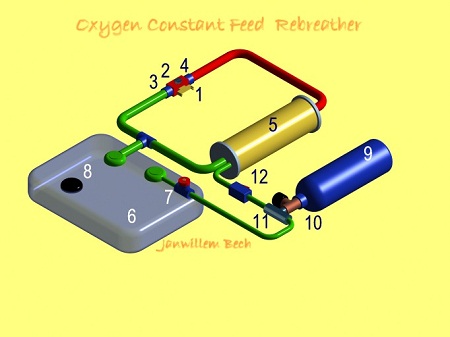
| The reason why the OR is the most used rebreather is because it can be dived for clandestine operations. Because the OR is a type of diving gear that does not produce bubbles it is the type used by the military all over the world. If you want to dive an oxygen rebreather you need to do a specialised course. The principle of the unit seems very basic, and in fact also is, but there are some dangerous aspects that need to be trained an known. | ||||||||||||||||||||||
The basics:The oxygen rebreather consists of a breathing loop usually with flapper valves that force the breathing gas in one direction. Also there is a scrubber that absorbs the carbon dioxide. The gas supply consist of a dosage system and oxygen cylinder. Finally the unit is completed with a counterlung. The counterlung is needed for the gas storage when the diver exhales the gas. Now when the diver swims he will use oxygen. Typically the oxygen consumption is :
|
||||||||||||||||||||||
 |
||||||||||||||||||||||
|
This is the old version of the oxygen rebreathers explanation page. There is a new full accessible database in English now with much more info on this kind of rebreathers HERE This page describes a CMF (constant mass flow) rebreather with manual bypass |
||||||||||||||||||||||
 |
The Parts of the oxygen rebreather are:
Through a dosage unit a constant MASS of oxygen is added to the rebreather. The quantity of oxygen is normaly just a little below the metabolic use of the diver. Usually 0,9 ltr/min. The diver breathes through the inlet valve (see # 3) the rich oxygenmix. After breathing out the gas leaves through valve (see # 4) in the direction of a scrubber (see # 5). The scrubber removes the carbondioxide. Now new oxygen is added in the next cycle. |
|||||||||||||||||||||
| The dosage
unit is also made in other ways: For additional ways of adding oxygen please check this page |
||||||||||||||||||||||
| NEVER USE THE
OXYGEN REBREATHER FOR DIVING DEEPER THAN 6 METERS ALWAYS FLUSH THE REBREATHER 3 TIMES ALWAYS DIVE IN BUDDY PAIRS ALWAYS FOLLOW A COURSE FOR YOUR SPECIFIC TYPE OF REBREATHER OXYGEN REBREATHERS EASILY KILL, PLEASE READ THE DISCLAIMER! |
||||||||||||||||||||||
